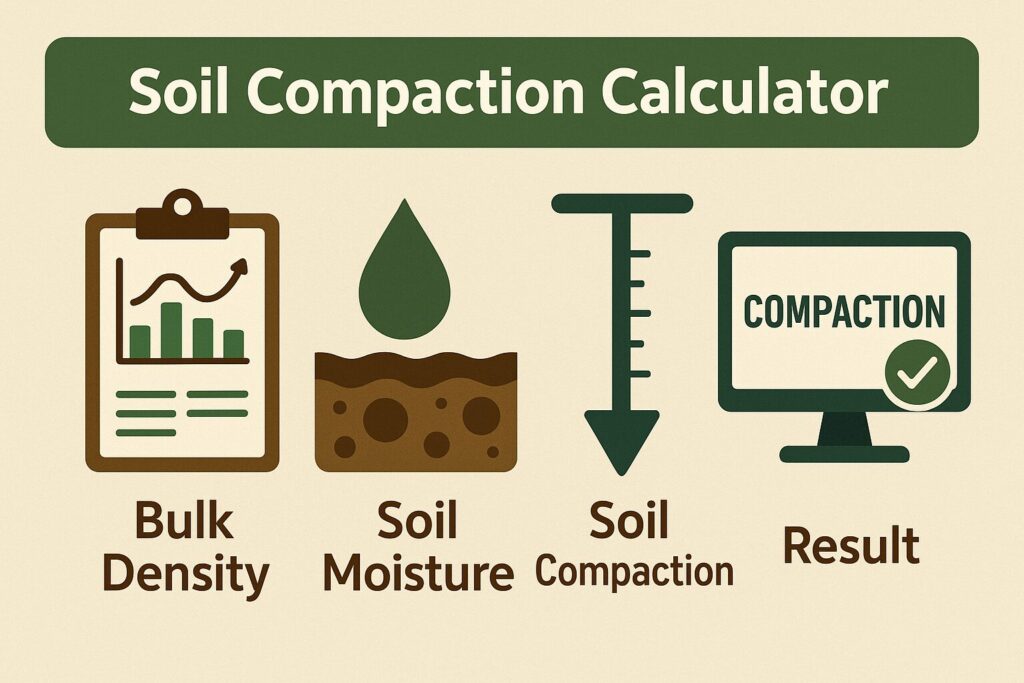Free Soil Compaction Calculator Online
In construction, landscaping, or roadwork, compacting soil properly is critical for creating stable foundations and long-lasting surfaces. A Soil Compaction Calculator from Construction Calculators helps determine how much soil is needed before and after compaction to achieve the desired fill depth and density. This tool is essential for estimating volume changes, material needs, and equipment efficiency during earthwork operations.
What Is a Soil Compaction Calculator?
A Soil Compaction Calculator is a tool that estimates:
- The increase in density of soil after compaction
- The reduction in volume due to compaction
- The amount of loose (uncompacted) soil needed to meet a compacted fill depth
- The number of equipment passes required for adequate compaction
Contractors, engineers, and landscapers use this calculator for:
- Road base preparation
- Foundation subgrade compaction
- Landscaping and topsoil planning
- Trench and pipe backfilling

Why Is Soil Compaction Important?
Proper compaction:
- Prevents settlement and cracking
- Increases soil strength and load-bearing capacity
- Reduces water infiltration and erosion
- Meets construction specifications for density
Failing to compact soil adequately can lead to structural failure, uneven settling, and costly repairs.
Key Inputs for Soil Compaction Calculation
1. Required Fill Depth (Compacted, in inches or feet)
This is the final depth of soil needed after compaction.
2. Compaction Factor (Shrinkage or Swell Factor)
This is a multiplier based on soil type. It reflects how much loose soil is required to achieve compacted volume.
Common compaction factors:
- Sand: 1.12 (12% more volume when loose)
- Gravel: 1.08
- Clay: 1.20–1.25
- Topsoil: 1.25–1.30
- Loam: 1.18
3. Area to be Filled (in square feet or meters)
Total surface area of the jobsite needing fill.
Compacted Volume Formula $$\text{Compacted Volume (ft}^3\text{)} = \text{Area (ft}^2\text{)} \times \text{Compacted Depth (ft)}$$
Loose Volume Formula (before compaction) $$\text{Loose Volume (ft}^3\text{)} = \text{Compacted Volume} \times \text{Compaction Factor}$$
Example Calculation
Let’s say you’re filling a 1,000 ft² area to a compacted depth of 6 inches using clay with a compaction factor of 1.20.
Step 1: Convert depth to feet
$$6 inches = 0.5 ft$$
Step 2: $$Calculate compacted volume1000×0.5=500 ft31000 \times 0.5 = 500 \text{ ft}^31000×0.5=500 ft3$$
Step 3: $$500 \times 1.20 = 600 \text{ ft}^3 \text{ of loose clay needed}$$
So, to achieve a compacted fill of 6 inches across 1,000 ft², you need 600 ft³ or about 22.22 yd³ of loose clay.
Common Soil Compaction Factors (Reference Table)
| Soil Type | Compaction Factor | Loose Soil Required (%) |
|---|---|---|
| Sand | 1.12 | 12% more |
| Clay | 1.20–1.25 | 20–25% more |
| Gravel | 1.08 | 8% more |
| Topsoil | 1.25–1.30 | 25–30% more |
| Loam | 1.18 | 18% more |
Volume Adjustments by Soil Type
If your design calls for compacted soil, always increase your order based on the soil’s compaction factor. A 1.25 factor means you need 25% more volume before compaction to meet design specs.
Using the Calculator for Lift Planning
Soil is typically compacted in lifts layers ranging from 6 to 12 inches thick, compacted one at a time. If your final fill is 18 inches:
- Compact in three 6-inch lifts
- Estimate material and time for each lift separately
- Ensure each lift reaches target density before adding the next
Moisture and Compaction Efficiency
Compaction success depends on moisture content and equipment type:
- Optimal moisture helps soil particles realign and reduce voids
- Too dry or too wet reduces compaction effectiveness
- Use a nuclear densometer or sand cone test to confirm density
Common Equipment and Typical Compaction Rates
| Equipment Type | Best For | Compaction Depth Per Pass |
|---|---|---|
| Plate Compactor | Granular soil | 4–6 inches |
| Rammer (Jumping Jack) | Cohesive soils | 6–8 inches |
| Vibratory Roller | Roads, subgrades | 10–12 inches |
| Sheepsfoot Roller | Clay and silt | 12+ inches |
Frequently Asked Questions
How do I account for multiple soil layers?
Calculate each layer separately using its own depth and compaction factor, then sum the total loose volume.
What if I don’t know the exact compaction factor?
Use 1.20 as a general estimate. For greater accuracy, refer to ASTM soil classification or project specs.
Can I use this for trench backfill?
Yes. Just input the trench area and desired compacted depth.
Do I need to compact topsoil for landscaping?
Yes, lightly. Over-compaction can hurt plant growth, but light compaction helps reduce settling.
How accurate is the soil compaction calculator?
It’s highly reliable if correct inputs are used. Field testing is still necessary to confirm compaction meets design density.
Conclusion
A Soil Compaction Calculator is a valuable resource in any earthwork or site preparation project. It allows you to estimate how much loose soil you need to order and apply, ensuring that your compacted fill meets project specifications. Whether you’re working with sand, clay, or gravel, this tool helps optimize your material usage, equipment planning, and jobsite timelines—keeping your build on solid ground from the start. You can find this tool along with the Building Square Calculator, Round Pen Calculator, and specialized Concrete Calculators at Construction Calculators.
